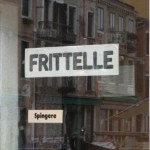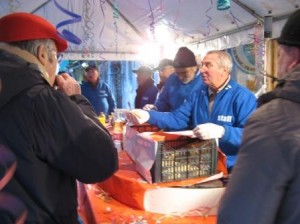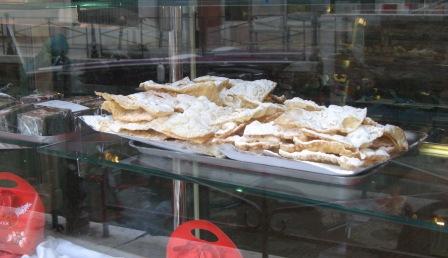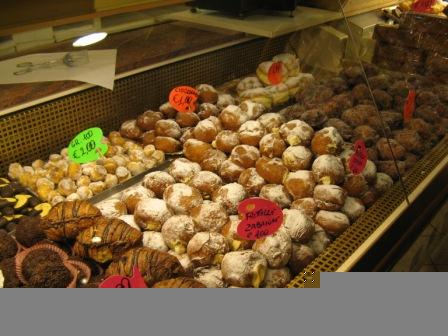
As if we needed any excuse — or permission — to gorge on food loaded with fat and sugar, today it’s take no prisoners. I haven’t found any special dispensation that promises that the fat and sugar consumed today will do less, or no, damage as they make themselves comfortable in their new home on your hips and in your arteries. But we can pretend. It’s Carnival, after all. No rules.
So the short version of today’s amusement can be summed up as: Fritole and galani. Venetians say that “El Zioba Grasso tute le boche lica” (“On Fat Thursday everybody licks their mouth”). More broadly translated: gorge, scarf, devour. Or my new favorite, “englut.” Makes me feel slightly sick without having eaten anything.
But even eating ten kilos of fritole and galani can’t match the excitement that was reserved for today back in the Olden Days.
The Venetian Republic made a fetish of commemorating important events in its life — every single victory, it would appear, and even some defeats. It all worked to keep Venetians united in their Venetian-ness and reinforce how very special, important, and amazing that was. And naturally any people who regard themselves and their city/nation/world in that light is bound to enjoy really laying it on when recalling certain events.
 Take that little business of Ulrich of Treffen, Patriarch of Aquileia. No need to lose ourselves in the maze that was Venice’s relationship with ecclesiastical power; let’s just say that for centuries religious disagreements were more commonly (and certainly clearly) expressed in political and military terms. Or, conversely, political and military projects almost always involved some highly placed representatives of the Prince of Peace.
Take that little business of Ulrich of Treffen, Patriarch of Aquileia. No need to lose ourselves in the maze that was Venice’s relationship with ecclesiastical power; let’s just say that for centuries religious disagreements were more commonly (and certainly clearly) expressed in political and military terms. Or, conversely, political and military projects almost always involved some highly placed representatives of the Prince of Peace.
So the Patriarch of Aquileia, after a decisive battle in 1162, was taken prisoner and carried off to Venice along with his 12 canons. They offered an unusual ransom for their freedom: A bull and 12 fat pigs, which they promised would be provided every Fat Thursday for 200 years. And so it was.
 Thus every Giovedi Grasso, to recall this glorious victory/humiliation, the public festivities involved the slaughter of the bull (the patriarch) and the fat pigs (the canons). Nice! I’m not referring to the aspect of blood, I’m referring to the aspect of insult. And everybody enjoyed it so much that it continued even after the 200 years were up.
Thus every Giovedi Grasso, to recall this glorious victory/humiliation, the public festivities involved the slaughter of the bull (the patriarch) and the fat pigs (the canons). Nice! I’m not referring to the aspect of blood, I’m referring to the aspect of insult. And everybody enjoyed it so much that it continued even after the 200 years were up.
In the early days of this entertainment, the bull was killed by the doge, and the pigs by the senators. (No comments, please.) Eventually Andrea Gritti (doge from 1523 to 1538), he of the palace which has become famous as a luxury hotel, decreed that the pigs be killed by members of the Butchers’ guild, while the bull would be dispatched by “the most robust member of the Ironworkers’ guild” with a single blow of a massive sword, a titanic decapitation in which the sword wasn’t allowed to touch the ground.
Even today, a common Venetian way of saying “Let’s get to the point” is “Tagliamo la testa al toro” — let’s cut the head off the bull. I hazard that “cut the bull” might be an Anglo-Saxon relative of the phrase and its meaning, but let’s move on.
So what did the doge and Senators do while the gore was flowing? They took clubs in hand and attacked 12 towers and a church made of marzipan, which they bludgeoned to smithereens.
 Me, bludgeonless, I went to the Societa’ di Mutuo Soccorso dei Calafati e Carpentieri for their fritola-fest this afternoon. This mutual-aid society, formed by the erstwhile Caulkers and Carpenters of the Arsenal, makes a specialty of sometimes organizing little neighborhood parties, almost exclusively intended for the kids. Although — from what I’ve seen — each kid seems to arrive accompanied by a phalanx of voracious relatives, none of whom appears starved for fat or sugar, and with the phrase “Me First” invisibly tattooed on their foreheads.
Me, bludgeonless, I went to the Societa’ di Mutuo Soccorso dei Calafati e Carpentieri for their fritola-fest this afternoon. This mutual-aid society, formed by the erstwhile Caulkers and Carpenters of the Arsenal, makes a specialty of sometimes organizing little neighborhood parties, almost exclusively intended for the kids. Although — from what I’ve seen — each kid seems to arrive accompanied by a phalanx of voracious relatives, none of whom appears starved for fat or sugar, and with the phrase “Me First” invisibly tattooed on their foreheads.
When we walked out the front door at 4:45, the voluptuous perfume of just-fried fritole suffused our little street. Looking around, we discovered that they were being turned out in the taverna two steps away. A taverna here isn’t anything like in Greece; here the word connotes somebody’s (usually a guy, often old) haven that’s something like a cross between a garage and a rec room, usually with some kind of primitive kitchen set-up. Evidently one of the caulkers was frying up a fresh batch for the refreshment table.
 It was a wonderful little interlude, out in via Garibaldi. The fritole were the best I’ve ever had, delectable little blobs, not too big, containing just the right amount of candied fruit and covered with a little more than the right amount of sugar. The galani were heavenly, shards of deep-fried dough thinner than onionskin, under clouds of powdered sugar. If there’d been more of a crowd I’d certainly have gone back for thirds, and fourths, and fifths. But I didn’t want the guys to start thinking, What — her again?
It was a wonderful little interlude, out in via Garibaldi. The fritole were the best I’ve ever had, delectable little blobs, not too big, containing just the right amount of candied fruit and covered with a little more than the right amount of sugar. The galani were heavenly, shards of deep-fried dough thinner than onionskin, under clouds of powdered sugar. If there’d been more of a crowd I’d certainly have gone back for thirds, and fourths, and fifths. But I didn’t want the guys to start thinking, What — her again?
What I really want to know, though, is where the leftovers ended up. I want to go there and help dispose of them as nature intended.








